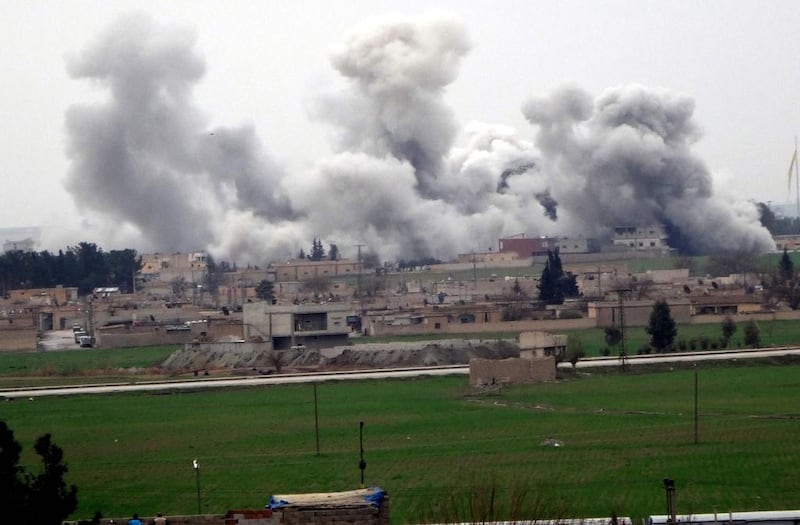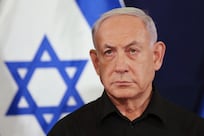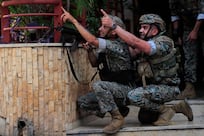A week after ISIL was reportedly expelled from its last stronghold in Hasaka, it launched an assault in Tal Abyad in northern Raqqa in the early hours of Saturday.
The militant group clashed with Kurdish militias affiliated to the People’s Protection Units (YPG), who drove ISIL from this border city in June last year. The attack on Saturday was ISIL’s second infiltration of the city since its defeat there.
During the clashes, ISIL fighters reportedly stormed the house of a tribal sheikh from Deir Ezzor living in Tal Abyad and beheaded him. Khaled Dahham Al Bashir – from the Baggara tribal confederation, one of the largest in Syria – was said to have been working with the YPG as part of the tribal component in the Syrian Democratic Forces, and was therefore an obvious target for ISIL. The ISIL assault on several different locations seemed carefully planned with specific targets.
Of particular significance was the fact that the YPG had to immediately call in US air strikes to repel the attack. The episode reveals a fault line in the way that the United States, the main backer of the YPG, fights ISIL in Syria.
The YPG’s victories against ISIL – in Kobani, Tal Abyad and southern Hasaka – were made possible largely because of intensive US firepower. According to military sources, the YPG lacks the capacity to defeat ISIL without close US air support. One source said that American air strikes account for “more than 90 per cent” of the ISIL defeats in those battles.
This is important if one contrasts the YPG with other forces in northern Syria that have defeated ISIL or repulsed its assaults for more than two years without any air support. Those forces would typically be fighting on two fronts at the same time. Rebel forces in Idlib, for instance, have kept the province free from ISIL despite repeated attempts to infiltrate it since 2014 – including at the peak of ISIL’s strength and morale after it defeated the Iraqi army in Mosul.
If the YPG could not alone defend Tal Abyad – which it seized eight months ago from a group that now operates tens of kilometres away from the city – that bodes ill for the current effort to uproot the organisation in Syria.
How long can the US air force serve as the brawn for the supposedly most formidable anti-ISIL force? With growing tensions between the YPG and the rebels on one hand, and the YPG and Turkey on the other, the US should rethink its approach to its overreliance on the YPG to combat ISIL, while continuing to support it in other ways.
The Kurds in Syria have legitimate grievances as I have long highlighted in this space. Both the regime and the opposition have failed to address their fears and aspirations before and after the Syrian conflict started, and the Kurds understandably see no future for themselves as part of either one of these sides. But the YPG has hijacked the Kurdish cause, and the US has no business allowing the fight against ISIL to be a tool to facilitate the YPG’s expansionist agenda – a process that has sometimes included acts of ethnic cleansing that, according to Amnesty International, “amount to war crimes”.
Whether in Syria or Iraq, the US should recognise that there is often a fine line between a force serving as a bulwark against extremism and being a conduit for it. The YPG did well expelling ISIL from Kurdish areas such as Kobani, and it was commendable for the US to provide air support.
But the YPG’s mission has clearly used the unconditional offer of air support to expand its military reach to link its sparse cantons in northern Syria.
Since the anti-ISIL air campaign began in September 2014, the US has worked mainly with the YPG and has ignored many fronts where serious blows could have been dealt to ISIL if the same air support had been provided to other anti-ISIL forces. These include eastern Aleppo, Idlib and Deir Ezzor.
This led many to conclude that the US is at least turning a blind eye to the YPG’s attempts to consolidate its northern enclave and to credible reports from human rights organisations of home demolitions and burnings. The YPG’s behaviour is clearly becoming a cause for concern.
ISIL plays a long game of exploiting social fault lines. Its targeting of the Baggara sheikh in Tal Abyad might be an example of this strategy, which includes assassination of community leaders who work with its enemies. They are its priority targets because they undermine its ability to polarise communities, a familiar tactic since 2005 in Iraq.
In the way it has conducted itself over the past few months, the YPG is helping ISIL achieve this objective one way or the other. And the US should be aware that as a tool to defeat ISIL, the YPG has reached a peak point.
America’s focus now should be to help fortify liberated areas militarily and internally by not allowing the YPG to use the anti-ISIL effort to seek an unsustainable project in northern Syria.
Hassan Hassan is a resident fellow at the Tahrir Institute for Middle East Policy, a think tank in Washington, DC, and co-author of ISIS: Inside the Army of Terror
On Twitter: @hxhassan





